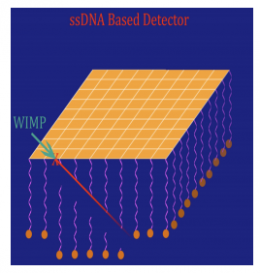July 3, 2012 report
Researchers propose gold and DNA based dark matter detector

(Phys.org) -- One of the precepts of scientific theory is that at some point, physical evidence should become available to prove it true. In physics this is an ongoing process in many areas of study, one of which is the detection and measurement of so called dark matter. Most astrophysicists agree it exists, yet no one has been able to definitively prove it though the presentation of physical evidence. While there are some ongoing projects attempting to do just that, the results have not been strong enough to offer proof. To overcome that problem a team of physicists and biologists have proposed a new type of detector based on a thin sheet of gold with many strands of DNA dangling below. The idea the team says in its paper uploaded to the preprint server arXiv, is to follow the path of a gold nucleus after being struck by a dark matter particle as it makes its way through strands of DNA, severing them as it goes.
Dark matter, the theory goes, is all around us, but we can’t see it or detect it using conventional means. Scientists believe it’s moving though, from the center of the universe towards us. The best analogy is water, in a stream; we’re like an island in it as is the sun. Thus, because we orbit the sun, and because our planet spins, we ought to be facing upstream sometimes and downstream others. That’s the basis of any dark matter detector, to first detect the weakly interacting massive particles, or WIMPs as researchers call them, and then to measure the amounts of them over the course of a day, or year to see if they conform to theory.
One way to build such a detector this new team says, is to dangle a dense forest of DNA strands from a thin sheet of gold. The idea is that when a WIMP strikes one of the gold atoms, its nucleus will be sent crashing down through the mass of DNA strands breaking the ones it strikes. Then, because each DNA strand would have a unique marker at its end, researchers could, by collecting the broken strands, figure out the trajectory of the nucleus though the strands and likewise that of the WIMP that struck it. Such a detector would go a long way towards proving that theories about dark matter are true.
Unfortunately, it’s not as simple as all that, because building such a detector would be a feat in and of itself. Making DNA strands that would be long enough to work in such a detector, for example, would be a challenge as would getting them all to align in a meter square trap and to dangle straight down instead of curling up.
On the other hand, the researchers say building such a detector would cost far less money than other efforts underway, and the detector once built would be far more accessible since it could be used at room temperature. Plus, if it worked, the team that built it would almost certainly go down in history as the scientists that finally proved that dark matter is real.
More information: New Dark Matter Detectors using DNA for Nanometer Tracking, arXiv:1206.6809v1 [astro-ph.IM] arxiv.org/abs/1206.6809
Abstract
Weakly Interacting Massive Particles (WIMPs) may constitute most of the matter in the Universe. While there are intriguing results from DAMA/LIBRA, CoGeNT and CRESST-II, there is not yet a compelling detection of dark matter. The ability to detect the directionality of recoil nuclei will considerably facilitate detection of WIMPs by means of "annual modulation effect" and "diurnal modulation effect". Directional sensitivity requires either extremely large gas (TPC) detectors or detectors with a few nanometer spatial resolution.
In this paper we propose a novel type of dark matter detector: detectors made of DNA could provide nanometer resolution for tracking, an energy threshold of 0.5 keV, and can operate at room temperature. When a WIMP from the Galactic Halo elastically scatters off of a nucleus in the detector, the recoiling nucleus then traverses thousands of strings of single stranded DNA (ssDNA) (all with known base sequences) and severs those ssDNA strands it hits. The location of the break can be identified by amplifying and identifying the segments of cut ssDNA using techniques well known to biologists. Thus the path of the recoiling nucleus can be tracked to nanometer accuracy. In one such detector concept, the transducers are a few nanometer-thick Au-foils of 1m times1m, and the direction of recoiling nuclei is measured by "DNA Tracking Chamber" consisting of ordered array of ssDNA strands. Polymerase Chain Reaction (PCR) and ssDNA sequencing are used to read-out the detector. The detector consists of roughly 1 kg of gold and 0.1 kg of DNA packed into (1m)^3. By leveraging advances in molecular biology, we aim to achieve about 1,000-fold better spatial resolution than in conventional WIMP detectors at reasonable cost.
Journal information: arXiv
© 2012 Phys.Org



















